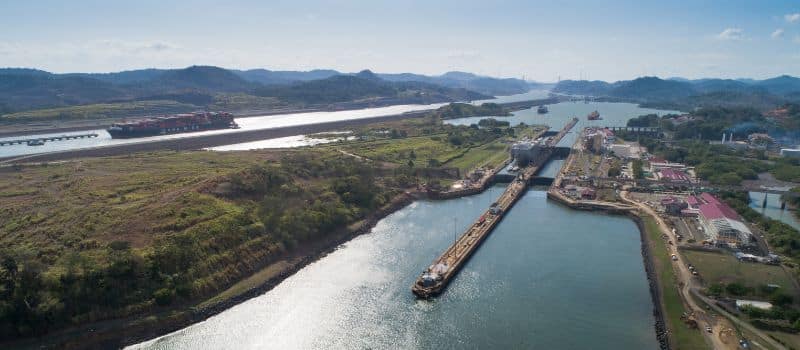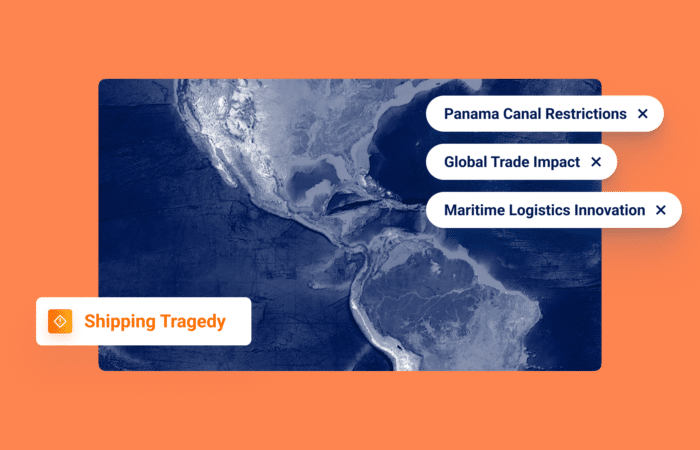What’s inside?
Over the last few months, one of the world’s most essential waterways – the Panama Canal – has been experiencing a severe drought. As our previous blog post mentioned, new restrictions were imposed on all vessels in early August. The repercussions of the restrictions have mainly affected the container shipping industry, yet there are growing indications of more ominous consequences. Despite its ongoing emphasis on prioritizing container traffic, the canal’s overall capacity is steadily diminishing.
Experts have warned of possible disruptions to maritime trade in the face of what is shaping up to be an even drier period next year – with some arguing that a possible early start to Panama’s dry season and above-average temperatures could increase evaporation and lead to near-record-low water levels in April 2024. This means that freight forwarders, importers, and exporters should be as best prepared as possible, especially with the upcoming holiday season.
As Isaac Hankes, senior weather analyst at the London Stock Exchange Group, explained, “Panama Canal water levels are likely to remain exceptionally low for months ahead yet, despite short-term improvements in the forecast.”

What is Currently Being Done to Handle the Drought?
The Panama Canal Authority (PCA) revealed that they will further reduce the maximum number of ships allowed to travel through the waterway from 32 per day in August to a new limit of 31. Under normal circumstances, the canal accommodated daily averages of 36 to 38 ships.
More than 14,000 ships traveled through the canal in 2022. Container ships make up the majority of traffic and carry an estimated 40% of consumer goods transported between Northeast Asia and the East Coast of the U.S. Obviously, this could disrupt U.S. manufacturing and retail if the levels don’t rise during the remainder of the rainy season.
As explained in more detail by Reuters: “To ease the bottleneck, the canal recently changed its reservation system to allow more non-booked vessels to pass and to prioritize ships waiting the longest. As of Tuesday, September 12, 116 vessels were waiting to pass in Panama, down from over 160 in early August. The maximum wait time was 14 days, down from 21 days a month ago, according to official data.”
While the PCA is working diligently to ensure a draft of 44 feet for ships, as approximately 70% of vessels require this depth, the drought continues to challenge their efforts.
This development is symbolic of a broader issue. The Panama Canal plays a pivotal role in global trade and provides fresh water to Panama City, home to nearly half of the country’s four million residents. With insufficient rain falling to replenish the watershed system that feeds the lakes and, subsequently, the locks, this crisis extends beyond maritime concerns.
To manage this, the PCA has set a limit of nine ships per day for the larger NeoPanamax locks, while 22 ships per day will be processed through the older Panamax locks.
How Does the Lock System Work?
As Business Insider explains, approximately 14,000 ships use the Panama Canal annually.
A crucial component of the canal is an artificial lake (Gatun) that is 85 feet above sea level. Vessels navigate the elevation changes via an ingenious water lock system, akin to a colossal elevator. As ships enter, they are gradually raised using water from Gatun Lake, lifting them to 85 feet above sea level. They cross Gatun Lake at this higher level.
Upon completing their journey across the lake, ships are lowered to sea level using the locks. On average, this entire process takes ships approximately 8 hours.
Three Critical Capabilities for Overcoming this Challenge
Innovative AI solutions can help freight forwarders, importers, exporters, and logistics managers overcome the canal’s reduced capacity challenges. Effectively managing unforeseen events in maritime logistics is crucial. Customized alerts, as part of Windward’s exception management platform, are available to enhance supply chain efficiency, customer satisfaction, and cost-effectiveness. In the face of the Panama Canal’s unique challenges, these tools empower businesses to identify and resolve anomalies in the maritime logistics process proactively.
1. Real-Time Predicted ETAs
The crisis at the canal often leads to delays. Access to real-time predicted ETAs through Maritime AI™ enables stakeholders to adapt to these disruptions and optimize their operational planning. Such insights are invaluable for making on-the-fly adjustments to routes and schedules.
2. Insights on Non-Feasible Paths
Effectively navigating the constraints of the Panama Canal necessitates a deep understanding of efficient and viable routes. Maritime AI™ provides insights into the feasibility of various paths, equipping decision-makers with the knowledge needed to make informed choices, thereby avoiding unnecessary delays and obstacles.
3. Port Congestion Insights
A comprehensive understanding of port congestion is essential for staying informed about the evolving situation in the Panama Canal region. This knowledge is vital not only for assessing the current state but also for anticipating how it may impact other areas and ports in the future.
The Path Forward
Adaptability and resilience will be paramount as the Panama Canal situation continues to unfold. The PCA, shipping, and ocean freight stakeholders must navigate this unprecedented challenge jointly, using the best technology available. Windward’s Maritime AI™ platform empowers decision-makers to proactively manage the dynamic landscape of the maritime industry, providing the tools needed to navigate unexpected hurdles.
The Panama Canal crisis is a stark reminder of the interplay between nature, global trade, and technology. While we cannot control the weather, we can harness the power of innovation to adapt to its effects. With the right advanced planning, cooperation, and technology, this crisis should remain manageable for the various stakeholders.














